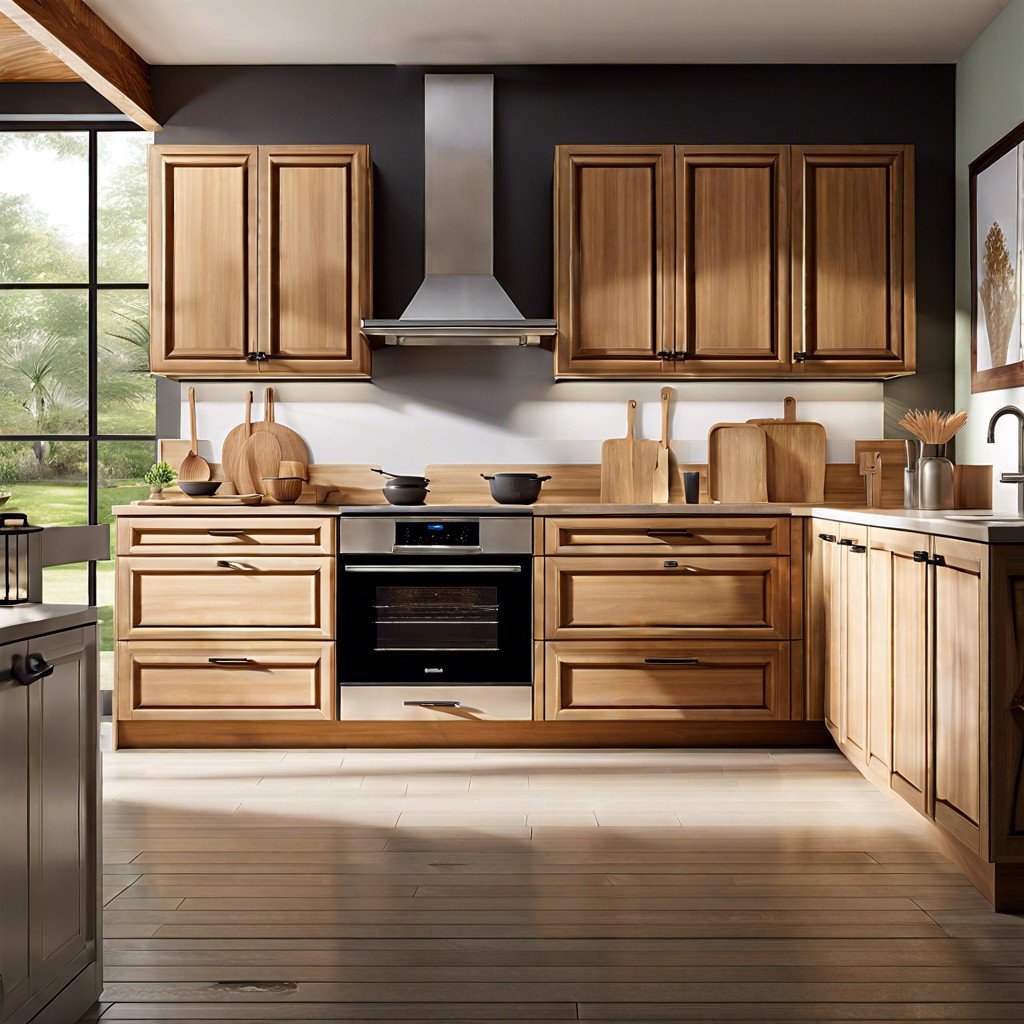Last updated on
Discover practical steps to effectively clean your kitchen cabinets and keep them looking their best.
Key takeaways:
- Different cabinet materials require specialized cleaning approaches
- Homemade solutions like dish soap and vinegar are effective and affordable
- Use white vinegar or citrus-based cleaners to tackle grease and grime
- Clean kitchen cabinets monthly or bi-weekly, depending on use
- Microfiber cloths and gentle cleaners are best for cleaning glass-front cabinets
What's Inside
Assessing Cabinet Material

Kitchen marathons and culinary escapades leave their marks. Often, these trophies of home-cooked feasts are splattered across cabinets. That’s why understanding your cabinet’s skin is paramount before diving into the cleaning spree.
Wood, thermofoil, laminate – they’re like different personalities demanding specialized approaches. A cleaner that makes laminate gleam might make wood wince. Think gentle for wood’s sensitive surface; mild soap usually does the trick. Meanwhile, thermofoil and laminate can handle more of a deep-clean dive with robust solutions.
For those sporting metal or glass – fingerprints and smudges be gone with a simple wipe of vinegar or a mild detergent. Remember, like choosing the right spice for a stew, selecting the appropriate cleaner for your cabinets is about balance and knowing the character of your materials.
Stay clear of harsh chemicals for a lacquered finish; a soft, damp cloth often suffices. Baking soda brings back the shine on many surfaces but use it sparingly – it’s gritty, with a penchant for leaving scratches if you’re not careful.
Preparing Cleaning Solution
Dive right into the mix, quite literally, with homemade solutions that are both effective and gentle on your wallet. A simple concoction of warm water and a squirt of dish soap does wonders for cutting through everyday dust and light stains. For stickier situations, vinegar is your go-to guy. Just mix a cup of white vinegar with a cup of water, and you’ve got a natural degreaser that’s tough on splatters but easy on finishes.
Baking soda comes in handy for stubborn spots. Create a paste with water, apply it to the tough stain, let it sit for a few moments, and then scrub gently with a soft cloth. It’s like a mini spa treatment for your cabinets, sloughing off the old to reveal the gleaming surface beneath.
Always spot test your solution in an inconspicuous area to avoid any heartache over discoloration or damage. After all, it’s better safe than sorry – or in this case, better a tiny test than kitchen distress.
Addressing Grease and Grime
Kitchen cabinets can often become a playground for grease and grime, particularly those close to the stove where oils and vapors congregate. Tackling this sticky woe is a breeze with a few household items and the right technique. Grab a bottle of white vinegar—nature’s own degreaser—to cut through the gunk. Mix it with an equal part of water and put some elbow grease into it with a soft cloth. Always avoid using abrasive scrubbers, which can harm the cabinet finish. Citrus-based cleaners are also effective; they break down the grease while leaving a fresh, clean scent behind.
For an extra level of shine and to create a protective barrier, consider the application of a thin layer of furniture polish or mineral oil after the cleaning. This helps in creating a slight defense against future buildup. Remember to rotate your cleaning cloths frequently—once a cloth gets too grimy, it can redistribute dirt rather than removing it. Work your magic consistently, and those cabinets will be free of grease and grime before you know it, making for a kitchen that beckons you to create and indulge in culinary delights.
How Often to Clean Kitchen Cabinets
Kitchen cabinets need regular attention to avoid buildup, but the timing can depend on your cooking habits and kitchen activity. A golden rule is a monthly wipe-down of exteriors with a soft cloth and gentle cleaner to combat dust and light stains.
For those who find themselves sautéeing or frying often, consider a bi-weekly inspection to keep grease at bay. The interior of cabinets, typically less prone to messes, can make do with a seasonal run-through unless spills occur. Remember, the areas around handles – where fingers constantly make contact – may need a bit more love, so a quick swipe with a damp cloth every week should do the trick.
While these guidelines can act as a compass, trust your eyes and nose. If you spot crumbs or detect a funky scent, it’s a clear signal: your cabinets are pleading for a cleanup session.
Tips for Cleaning Glass-Front Cabinets
Glass-front cabinets add elegance to any kitchen, but they also showcase every fingerprint and smudge. Start by wiping the glass with a microfiber cloth to remove dust. Avoid paper towels that can leave lint or scratches.
For a streak-free shine, mix equal parts of white vinegar and water in a spray bottle. Spritz lightly on the glass, not directly on the cabinet to prevent moisture seeping into the wood. Buff with a clean, dry microfiber cloth in a circular motion for gleaming results.
For stubborn gunk, a dab of toothpaste on a soft cloth can work wonders. Apply gently and watch as it lifts away the grime without scratching the surface. Remember to avoid harsh scrubbers that can damage the glass.
Lastly, address cabinet handles. They’re high-touch areas that can get sticky. Simply dip a cloth in soapy water and give them a thorough wipe. For intricate designs, an old toothbrush can get into the crevices, ensuring your hardware sparkles just as much as your glass fronts. Remember to dry the handles to prevent any water spots.




